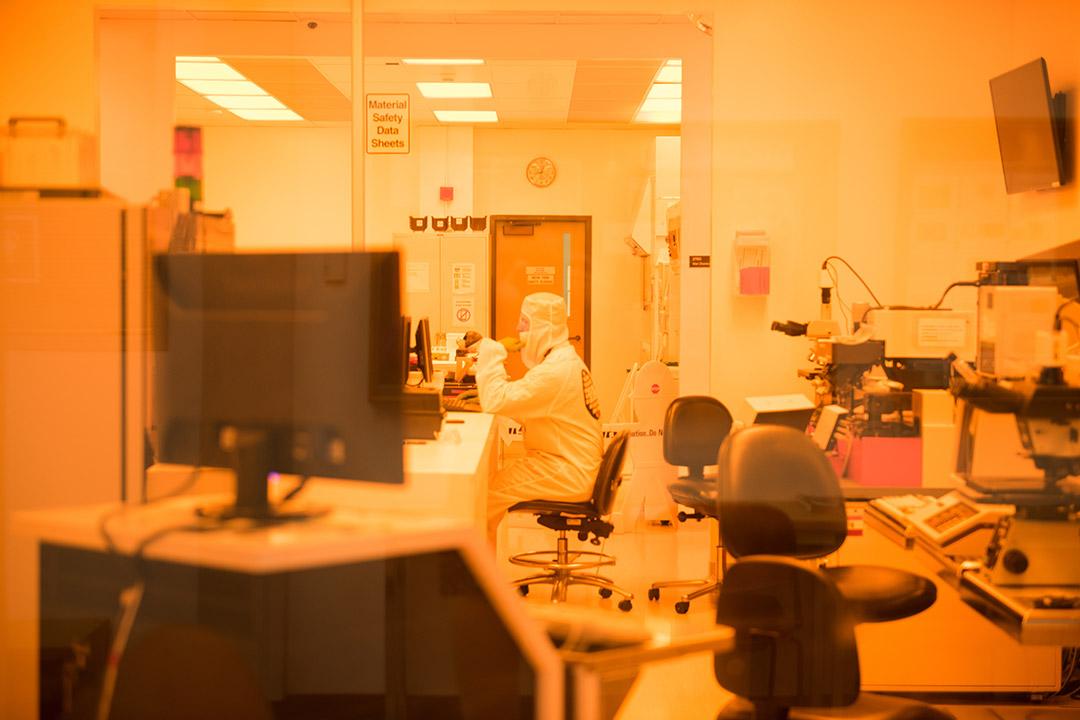RIT receives $1 million grant to upgrade and expand its cleanroom facility
State funding advances growth in semiconductor and biomedical research
Meghan Marin
The Semiconductor Manufacturing and Fabrication Laboratory in the Kate Gleason College of Engineering will be renamed RIT NanoLabs to reflect the growth in microelectronics and biomedical devices technology research and development.
The Kate Gleason College of Engineering at Rochester Institute of Technology was awarded a $1 million Higher Education Capital Matching Grant (HECAP) from New York state. The award will be used to upgrade and expand the college’s cleanroom facility to accommodate the growth of research in biomedical technologies such as drug delivery and lab-on-chip devices.
RIT researchers are building upon the institution’s long and successful history of semiconductor and microsystems research, said Doreen Edwards, dean of RIT’s Kate Gleason College of Engineering.
“The demand for computer chips is outpacing supply in the U.S. We are producing graduates who have the skills to help solve this problem. The fabrication techniques used to build computer chips are critical to many current and future technologies,” said Edwards. “The timing of this grant couldn’t be better.”
Semiconductor research and development is integral to the growth of newer technologies such as artificial intelligence, quantum computing, biomedical sensors, and integrated photonics. These technologies will enable advances in smart systems for healthcare, transportation, manufacturing, defense and security, among others.
The name of the cleanroom facility is being changed from the Semiconductor and Microsystems Fabrication Laboratory to RIT NanoLabs to better reflect the full range of research that it supports.
RIT researchers will use the facility for research in photonics, quantum chip development, microfluidic devices, LEDs, solar cells, and nanomembranes. The facility will continue to support CMOS processing—a chip fabrication process that is widely used in industry. Early-stage companies will continue to use the facility to develop new products.
“This reflects on how we work with, and look at, the needs of industry,” said Karl Hirschman, RIT’s Micron Professor of Microelectronic Engineering. “They need to see a platform where they can integrate device technologies. Even if it is just proof-of-concept, we can do that. CMOS is today’s bread and butter of microelectronics. That's what we’ve done, and that’s what continues to move us forward.”
Project planning is underway, and Phase I construction will launch in January 2022. Changes will include upgrades to filtration and air handling systems, the addition of new wet processing stations to prevent cross contamination, and the creation of 5,000 square feet of collaborative research space focused on biomedical applications.
The current cleanroom was built in the mid-1980s to complement the microelectronic engineering degree program, which began in 1982. The first of its kind at the time, the microelectronic engineering program led the way to train engineers in what would become a powerful global industry.
Today, the cleanroom serves as a teaching and research lab, a testing facility for corporate partners, and a resource for multiple levels of workforce development training.
“If the government is making an investment to address the shortage in U.S. chipmaking, then we’re certainly well-aligned with whatever they want to invest in—especially in providing engineers to these industries. We have an unmatched undergraduate program,” Hirschman said.
